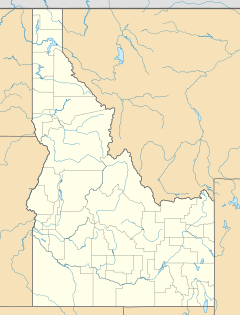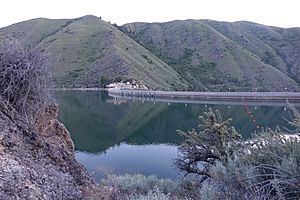Arrowrock Dam facts for kids
Quick facts for kids Arrowrock Dam |
|
|---|---|

Spillway and dam in May 1993
|
|
|
Location in southwestern Idaho
|
|
| Country | United States |
| Location | Boise and Elmore counties, Idaho |
| Coordinates | 43°35′44″N 115°55′20″W / 43.59556°N 115.92222°W |
| Purpose | Irrigation |
| Construction began | 1911 |
| Opening date | 1915 |
| Owner(s) | U.S. Bureau of Reclamation |
| Dam and spillways | |
| Type of dam | Arch dam |
| Impounds | Boise River |
| Height | 350 feet (110 m) |
| Length | 1,150 feet (351 m) |
| Reservoir | |
| Creates | Arrowrock Reservoir |
| Total capacity | 300,850 acre-feet (0.371 km3) |
| Catchment area | 2,200 square miles (5,700 km2) |
| Surface area | 3,100 acres (12.5 km2) |
| Normal elevation | 3,210 ft (978 m) AMSL |
| Power station | |
| Operator(s) | Boise Project Board of Control |
| Commission date | March 2010 |
| Installed capacity | 15 MW |
|
Arrowrock Dam
|
|
| NRHP reference No. | 72000437 |
|---|---|
| Added to NRHP | 1976 |
The Arrowrock Dam is a large concrete arch dam located on the Boise River in Idaho, United States. It opened in 1915. The dam sits between Boise County and Elmore County. It is upstream from the Lucky Peak Dam and its reservoir.
The main job of Arrowrock Dam is to provide water for farming. This water is used to irrigate crops. The dam was recognized as a National Historic Civil Engineering Landmark in 2016. This award came from the American Society of Civil Engineers.
Contents
Building the Dam: Early Steps
In 1910, the U.S. Bureau of Reclamation looked for a new place to store water. They wanted to build another facility on the Boise River. Engineers chose the Arrowrock site. A private company had tried to build an irrigation project there before, but it failed.
The Arrowrock site was perfect because it was where the main river met its south fork. This dam would be the biggest project the Bureau of Reclamation had ever done. At 348 feet (106 m) tall, Arrowrock was planned to be the largest concrete arch dam in the world.
Getting Supplies to the Site
Before building could start, a lot of preparation was needed. The dam site was about 20 miles (32 km) up the Boise River from the Boise River Diversion Dam. Getting supplies there was a huge challenge. The Bureau of Reclamation decided to build a new railroad. This railroad would follow an old wagon road. It would start near the Diversion Dam and go through a winding canyon to Arrowrock. Work on the rail line began even before the dam was fully approved.
Building the railroad had some problems. The Barberton Lumber Company owned the land where the road would go. The government had to make a deal with them. The government agreed to lease the tracks from Barberton. However, the government would run the trains itself. This made the Arrowrock & Boise Railroad the first publicly owned train line in the nation. The Bureau of Reclamation kept this fact secret from President William Howard Taft. Luckily, Taft approved the dam project in June 1910.
Later, the Oregon Short Line Railroad refused to work with the Arrowrock & Boise line. This meant the Arrowrock & Boise terminal was moved to a field. On August 22, 1910, the final deal was made. Work on the railroad to Arrowrock began.
Life at the Dam Site
The Manly Brothers from Salt Lake City won the contract to grade the railroad in May 1911. Government workers laid the tracks. The work was sometimes delayed because of a shortage of railroad ties. But the tracks were finished by early November. The train ride through the canyon was long and difficult. For a few months, passengers had to get off at the unfinished Gooseneck Bridge. The train cars were then pulled across one by one.
When people arrived, they were often surprised. The view was amazing. The "work" camp also had comforts that some people in the area didn't have. The site had electricity, a central heating system, running water, and a good sewage system. The Arrowrock camp also had a hospital, a dining hall, a post office, and a hotel. Workers could stay in bunkhouses or private rooms.
The camp also had a YMCA, a school, and a dance hall. At its busiest, about 1,400 people lived at Arrowrock. This included about 200 families.
Powering the Project
To get electricity for the site, the Bureau of Reclamation updated the Boise River Diversion Dam. They added a small power plant there. This plant was finished in 1912. Its three generators made 1,500 kilowatts of electricity. This power was used for the Arrowrock camp, sawmills, and large cement mixers. The plant used special German-made turbines. These were the first in the world to have a vertical shaft design.
Along with power lines, phone cables were installed. This connected Arrowrock to the outside world. In 1976, this power plant was added to the National Register of Historic Places. It was updated in 2002. Now, it is on standby and sometimes provides extra power when needed. The original parts of the power plant were kept for historical reasons.
Building the Dam: Work Begins
Work on the Arrowrock Dam started in early 1912. It moved very quickly. More workers were available because other dam projects had finished. This meant wages for workers went down. Regular laborers earned $2.40 a day. Skilled workers made $3.00 to $4.00 a day. Money was also taken out for room and food.
Workers could choose to stay in dorm-style bunkhouses for $1.25 a month. A private room cost $4.00 a month. Seventy-five cents was taken out daily for meals. One dollar a month went to hospital costs. The work was somewhat dangerous. Many workers were injured, and twelve people died. Despite the dangers and lower pay, workers at Arrowrock seemed to get along well. They set many construction records. One record was for the 527,300 cubic yards (403,100 m3) of concrete poured for the dam.
The Bureau of Reclamation used excellent equipment at Arrowrock Dam. They had a large 70-ton steam shovel. They also had two smaller 18-ton excavators and new dump cars. The cement mixers made over 2,000 barrels of cement each day. They ran almost non-stop for 30 months. Two large cableways moved materials and concrete to the dam site. Many horse teams helped carry equipment and gravel.
Cars and trucks also helped. One Buick and seven Ford trucks moved crews and visitors. This made travel around the campsite easier. To make the train ride more comfortable, the Bureau of Reclamation bought a new 60-ton train and passenger cars. For almost five years, the train ran reliably through the canyon. It carried over 89,500 visitors and workers. The train traveled more than 110,000 miles (180,000 km) and carried 14,000,000 tons of freight.
Dam Dedication and Features
The Arrowrock Dam was officially opened on October 4, 1915. It was the tallest dam in the world for nine years. The Schräh dam in Switzerland became taller in 1924.
Engineers used new methods at Arrowrock. They placed ten thermometers deep inside the dam's concrete. This helped them control the temperature of the concrete as it set. This made sure the dam was very strong. The dam is 225 feet (69 m) thick at its base. It is 15 feet (4.6 m) thick at the top.
The dam has 25 outlets. Some of these outlets can control themselves, which was another new invention. Ten outlets were built for a future power plant, but they have not been used yet.
In total, the dam used 585,160 cubic yards (447,390 m3) of concrete. The reservoir holds over 286,000 acre-feet (353,000,000 m3) of water for irrigation. In the first week after it opened, about 12,000 visitors came to see the dam. They braved the canyon train ride. As fewer people visited, the train schedule was cut. The busy camp quickly became like a ghost town. On August 11, 1916, the government stopped running its first public train line.
Updates and Modernization
From 1935 to 1937, the dam was made 5 feet taller. This increased its water storage by 9,000 acre-feet. Old concrete on the dam's downstream side and spillway was also replaced.
Between 2001 and 2004, ten old valves were removed. They were replaced with new clamshell gates. By 2011, all five sluice gate outlets were permanently plugged.
A 15-megawatt (MW) power plant was added to Arrowrock Dam in March 2010. The power lines to the dam were also updated.
Images for kids




